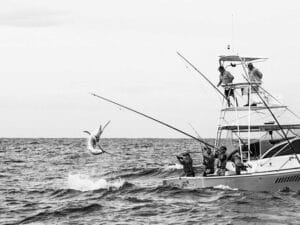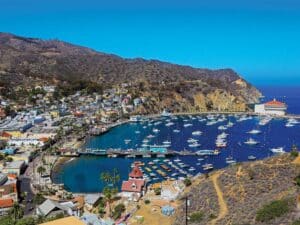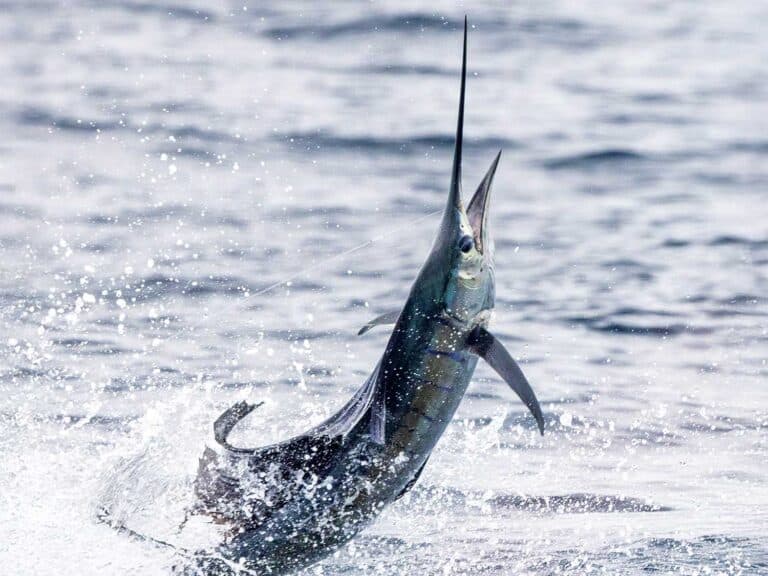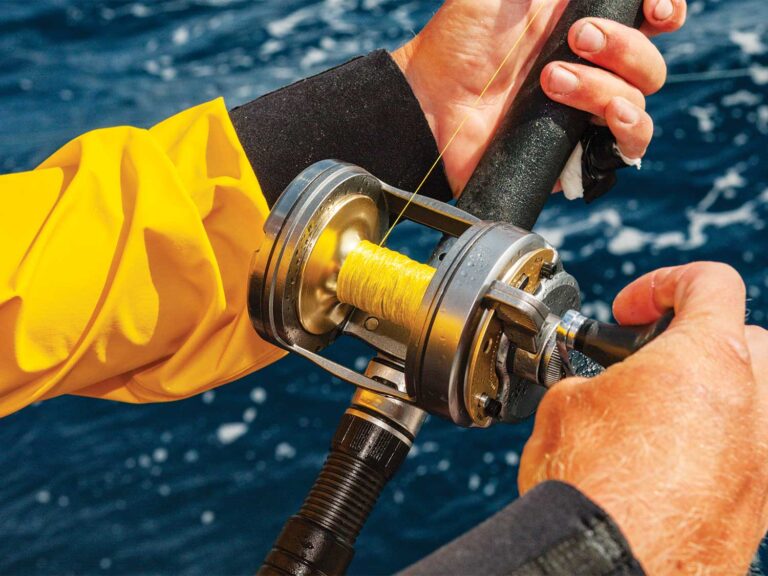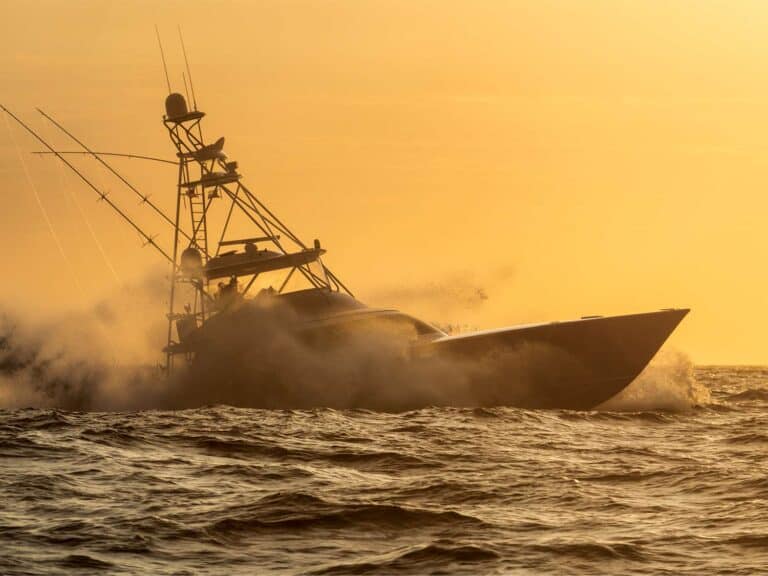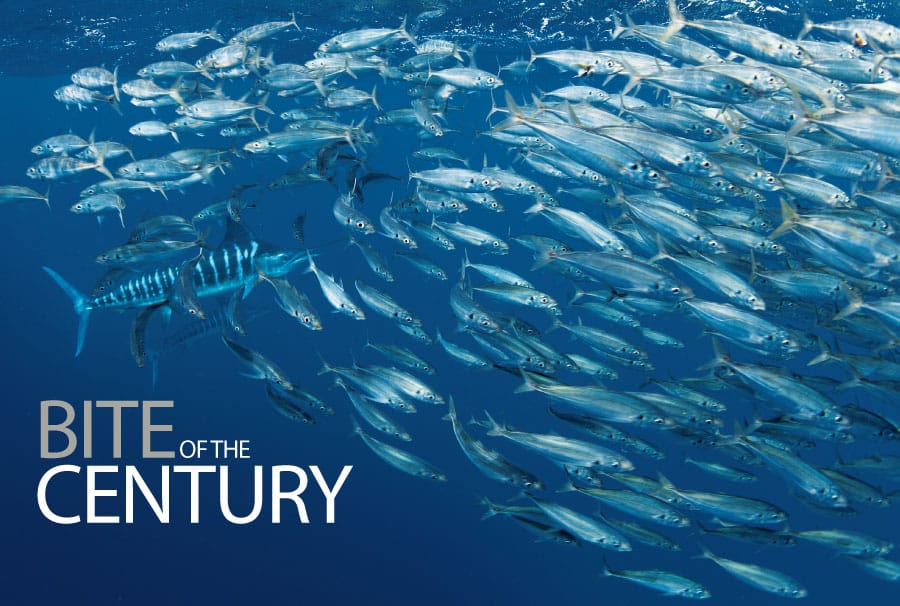
It was a sight to behold: calm seas, no land visible, and more than 150 boats all tightly packed together over the bait schools. Equally impressive as the number of boats was the fact that each one seemed to be constantly hooked up. Every few minutes, a boat would charge out of the pack in hot pursuit of a high-flying marlin. More often than not, several boats would speed off at once, making for some exciting moments as the boats weaved around each other, trying to keep the fish apart and stay attached at the same time.
But the bite didn’t last just an hour or two around the tide, as it normally does; it went on all day. “At no time during the day did I not see at least one boat fighting a fish,” says Shaun Whale, publisher of the Aussie fishing magazine Modern Fishing.
I fish these rich waters every year, and I’ve never seen so many fish caught. For a fishing journalist, it was paradise. I seemed to be constantly reaching for the camera as yet another boat hooked up close by.
By the end of one very hot day’s fishing, the fleet tallied a staggering number of releases: Flying Fisher, 11; Sniper, 11; Viking On, 10; Diversion, 12; Calypso, 13; and the list went on. But the best effort went to Darren Buttigieg, on the 21-foot trailer boat Happy Hour, who managed to catch 15, including a triple-header.
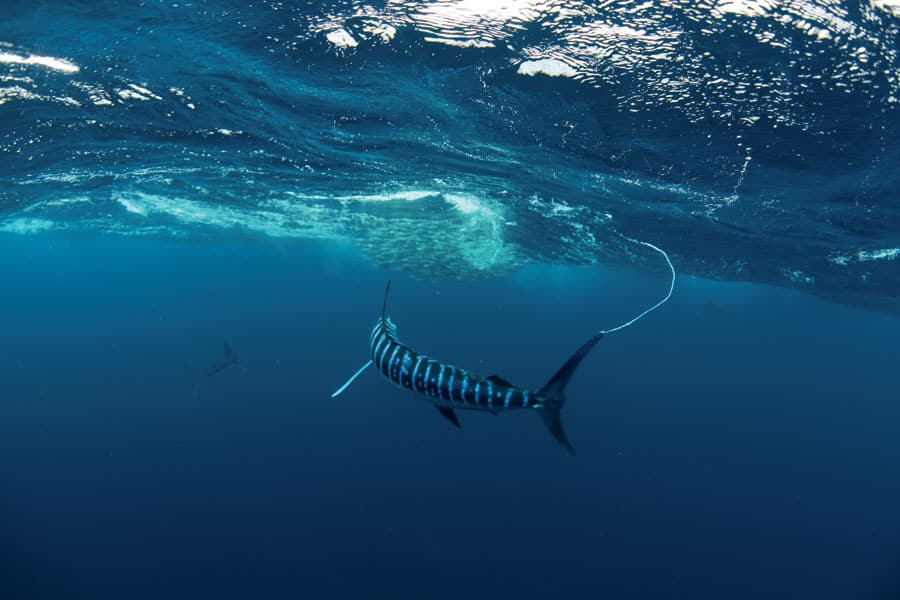
Throughout February, the bite continued, and the number of anglers at Port Stephens on the New South Wales coast rose considerably. While anglers caught a few fish inshore, most big days came on the infamous Car Park grounds just offshore. Just 24 miles southeast of the port, the Car Park enjoys a reputation as a striped marlin magnet, but this season it reached a new level, with anglers releasing hundreds of fish on a daily basis.
“The bite just wouldn’t stop,” says Scotty
Thorrington, the skipper on Flying Fisher. “Every day we just kept catching them. We averaged more than three fish a day, and regularly caught five or six.”
These weren’t small striped marlin, either; fish in the 160- to 220-pound range dominated the catches. Fortunately, there was also a good mix of black marlin, some weighing more than 400 pounds, and even the odd blue marlin thrown in as well.
Traditionally, the Port Stephens billfish bite starts in late January, peaks by mid-February, and then steadily slows down as the current pulls up; however, 2012 proved to be an entirely different story. “The current held, and the fish just kept snapping their heads off right through to the end of the month,” says Capt. Bobby Jones on Iceman. The fishing was so good that it became rare to not tag a fish, and in fact, on Strikezone our worst day of the season was two releases. Never before had we caught a fish every single day — you always catch a few slow days, where you end up with zeros.
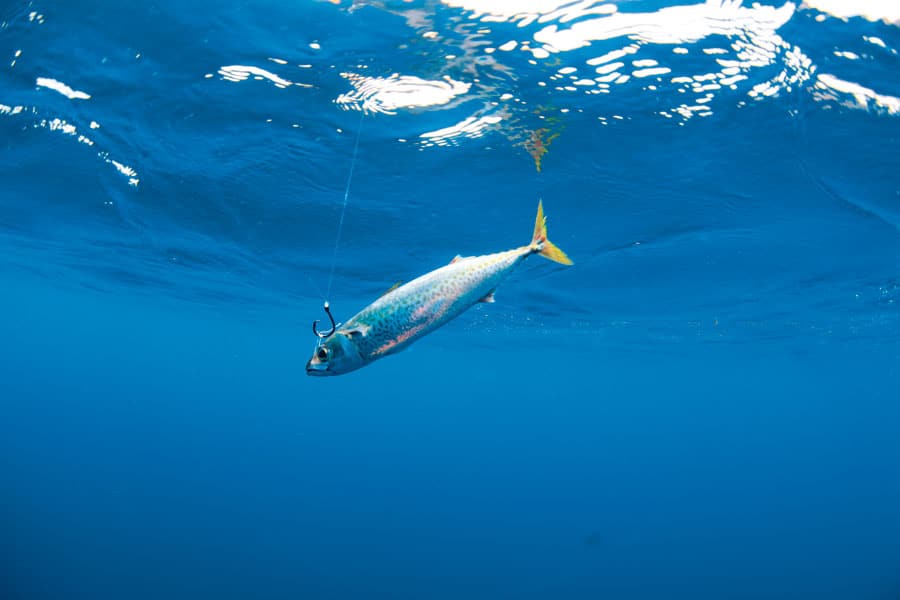
Port Stephens
Australia’s first marlin caught on rod and reel came in Port Stephens, and today the area still produces more marlin than any other spot in Australia.
The marlin can be caught just outside the port’s entrance, among the islands. However, sadly, the introduction of a marine park saw many of these inshore grounds locked up. Luckily, the main marlin grounds are outside the reach of the dreaded NSW Marine Park Authority’s reach.
When you think of hot marlin grounds, you usually picture dramatic canyons, reefs or seamounts. However, the Car Park offers up none of these fish-attracting attributes. Instead, it is comprised of a featureless bottom covering a couple of square miles along the 80-fathom line just inside the edge.
The bottom may be featureless, but it provides a fertile environment that stacks up massive amounts of bait. It’s the currents that are the trick here. Seal Rocks juts out to the north, kicking the current out to sea. This forms a natural eddy on the inside edge of the main current, just like the currents in a stream kicking off a rocky point, except it’s on a much bigger scale. When the back eddy pushes in over the shelf, it creates an upwelling. Bait schools of mackerel, yellowtail and even leather jackets (triggerfish) stack up in such massive numbers that they can completely black out the sounder at times. These concentrations of fish ring the marlins’ dinner gong, and the billfish arrive in droves, surfing a ride on the southerly current to take advantage of the feast.
Another unique aspect of this fishery is where all the action takes place: down deep below the surface. With the bait holding in the bottom half of the water column, there’s usually little surface activity to give away the activity down below. Of course, the use of live bait is by far the best technique to target these deep-feeding marlin, suspending the baits at varying depths as you drift over the baitballs. “Sitting on the bait schools soaking livies may not create the biggest adrenaline rush, but it is deadly effective and will get you the numbers,” says Strikezone angler James Yerbury. “And, believe me, this is the place to stack up some serious numbers.”
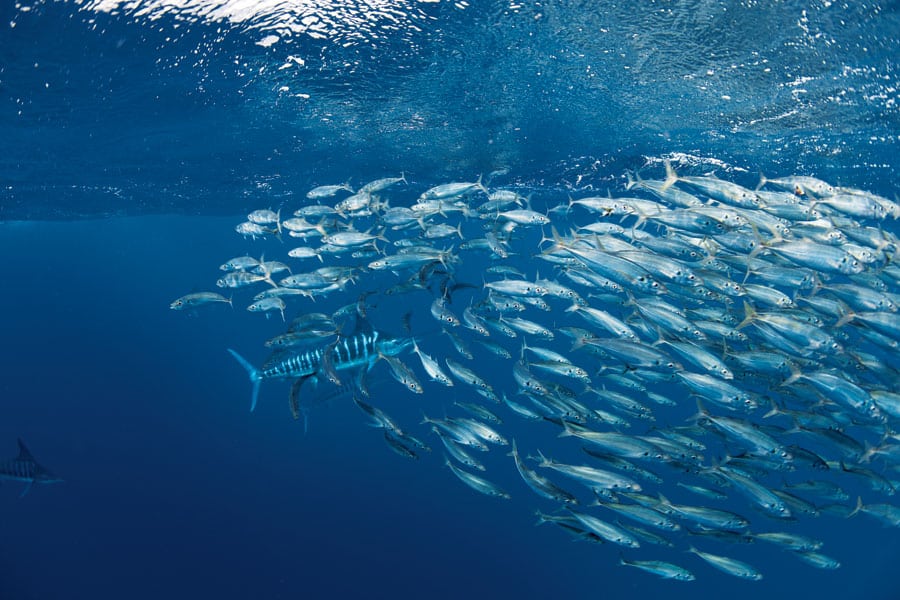
Changing Techniques
The awesome fishing came at a price: Suddenly, we found ourselves surrounded by boat traffic. The whole world may be suffering from a downturn in the economy, but that didn’t stop everyone with a boat from going marlin fishing in Australia!
The fact that everyone was live-baiting — with all the boats sitting on top of each other, jockeying for pole position over the bait schools — made things worse. “There was no question where this spot gets its name from,” Yerbury says.
The increase in fishing pressure saw an increase in competition, and the fish quickly wised up as the season progressed. If you take the average of three baits per boat and multiply it by 150 boats, suddenly your mackerel is competing with 450 other baits!
With the fish being exposed to so much gear, they naturally became a lot more cautious. “From the fish’s perspective, with so many choices, if there was even the slightest hint of something amiss, they would reject the bait,” Thorrington says. “Suddenly, crews started paying close attention to their rigs, especially the leader.”
“The old days of using 400-pound leaders were gone, and everyone worked out that they get more bites by dropping down in leader size,” says Vic Levett, the skipper on Mojo. But the size wasn’t the only thing that mattered. Crews quickly realized the advantages of using fluorocarbon. Most serious crews that used 250-pound monofilament switched over to 130- or 180-pound fluorocarbon. “During the tournaments, some of the top boats dropped right down to 100-pound fluorocarbon to pull the bites right in the middle of the crowds. Sales of lighter leaders have gone through the roof, especially the fluorocarbon,” says Mick Latimer, who owns the Compleat Angler shop. “Fluorocarbon used to gather dust on the shelf, but now we can’t keep enough in stock.”
And it’s not just the leaders that have been shrinking in size. The hooks are getting smaller too. “We used to run heavy-gauge 14/0 circle hooks, but have now dropped down to 9/0s and sometimes even smaller,” says Adam Polly, the skipper on Mistress. Superfine-gauge hooks are also coming into play, and while it’s important not to pull too hard, some crews swear by them.
Some anglers are going one step further and streamlining the whole rig. Big, chunky snap swivels have been replaced by slim, small-barrel swivels like Halcos, which are insignificant and hard to see. There is also a trend back toward tying hooks rather than crimping them. While this can be a bit tricky with fluorocarbon, and you have to be sure to pull the knot in supertight, it does help to make the rig less obvious, and if it gets you an extra bite, then it is worthwhile.
Downsizing the tackle has forced crews to rethink the way they fight the fish. They are fishing a lot more gently to avoid pulling the hook. Manhandling the fish to the boat and then taking the wire and hanging on saw more than a few fish quickly snapping off, often before the tag went in. “We have had to learn to go a lot lighter on the leader, as you would with a big tuna, and guide the fish in, as opposed to bullying it in and its working a treat,” Thorrington points out. As they say, it’s all about the bite, and you need to get the fish on first; then you can worry about fighting it right.
On the other side of the equation, releasing the fish is becoming a lot easier with the lighter leaders. After the fish has been tagged, a quick tug on the leader should see the line snap right at the hook. “This is great for the fish,” says Phil Bolton, director of NSW Game Fishing Tagging Program. “With no trailing leader hanging out and minimal chance of the fish beating itself up against the boat, it means the fish swim away fit and healthy.” Also, there has been an unprecedented increase in recaptures this season.
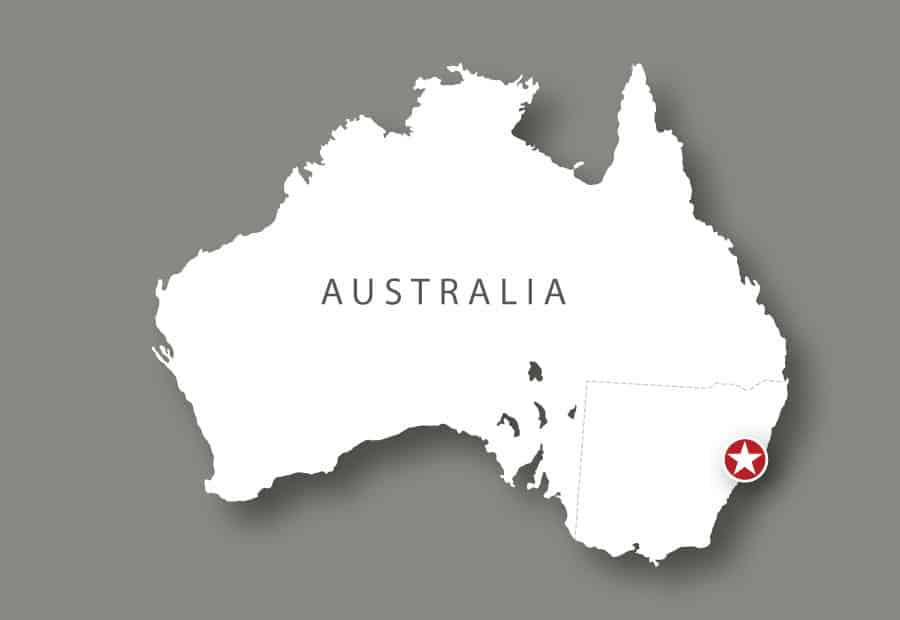
Underwater Observations
This season we experimented by trolling a Towcam underwater camera, not just to collect footage but also to see how many fish we were actually raising and whether they were shying away from the gear. The results were really quite surprising. Early in the season, the fish were a lot more aggressive and less concerned about the gear. However, as the crowds grew, things changed. We started to see more fish, but the number of bites dropped. Early on in the season, we were seeing several fish a day and getting bites from roughly six; however, at the peak of the season, we were seeing seven to 10 fish a day, but only scoring three to four bites. Interestingly, a lot of fish cruised right up to the camera to inspect the bait, check out the camera, and then cruise on.
One of the most spectacular moments we filmed was of a marlin charging in and chasing off a pod of dolphins. I always figured that dolphins were higher up in the aquatic hierarchy than marlin, but this footage shows quite the opposite. It turns out that we know very little about what’s going on.
A personal observation: Since I started jumping in and filming marlin underwater, I have been shocked by just how much even a 200-pound leader stands out, as does the hook and even the swivel. Watching striped marlin, it was obvious that they could see the line, and I regularly witnessed them shying away from the hooked bait. Refining your tackle makes a lot of sense. The 2012 season will go down as one of the best bites in history in Australia. A month of nonstop marlin fishing has prompted anglers and crews to refine their techniques and ultimately really made us change the way we fish.
